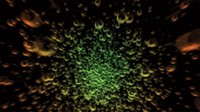Advertisement
Grab your lab coat. Let's get started
Welcome!
Welcome!
Create an account below to get 6 C&EN articles per month, receive newsletters and more - all free.
It seems this is your first time logging in online. Please enter the following information to continue.
As an ACS member you automatically get access to this site. All we need is few more details to create your reading experience.
Not you? Sign in with a different account.
Not you? Sign in with a different account.
ERROR 1
ERROR 1
ERROR 2
ERROR 2
ERROR 2
ERROR 2
ERROR 2
Password and Confirm password must match.
If you have an ACS member number, please enter it here so we can link this account to your membership. (optional)
ERROR 2
ACS values your privacy. By submitting your information, you are gaining access to C&EN and subscribing to our weekly newsletter. We use the information you provide to make your reading experience better, and we will never sell your data to third party members.
Biomaterials
Rhamnolipids rise as a green surfactant
Advances in manufacturing are bringing a biosurfactant up to commercial scale
by Craig Bettenhausen
June 13, 2020
| A version of this story appeared in
Volume 98, Issue 23

In the next few weeks, a facial cleanser will hit the market based on a new surfactant: rhamnolipids.
Booni Doon’s Calm Cleansing Capsules are one of the first consumer products in the US to feature the promising biosurfactant. Last year in Chile, Unilever launched a variety of its Quix dish soap based on rhamnolipids from Evonik Industries. And earlier this year, in another sign of confidence, the surfactant maker Stepan purchased the NatSurFact rhamnolipid business from Logos Technologies.
Industry insiders say the time is right for rhamnolipids after years of promise but little use in consumer applications. New production technology is starting to operate that can produce them at commercial scale. At the same time, consumer demand is increasing for milder ingredients that are biobased, biodegradable, and sustainable. “Not many ingredients tick all the boxes,” says Hans Henning Wenk, vice president of R&D Care Solutions at Evonik, but rhamnolipids do.
A surfactant, short for surface active agent, is any molecule that attracts both polar and nonpolar substances, decreasing the surface tension between them and allowing them to mix. Soap is one type, as are conventional semisynthetic surfactants such as sodium laureth sulfate, which is made by chemically modifying tropical oils.
The biggest market for surfactants is home and personal care, accounting for three-quarters of the $40 billion in annual surfactant sales, according to industry veteran Neil Burns. Other large markets include cosmetics, agriculture, enhanced oil drilling, and environmental remediation.
The industry defines biosurfactants as natural surfactants excreted by an organism. Commercially, they’re made by large-scale fermentation of oil, sugar, or a combination of the two. In the case of rhamnolipids, they don’t need any chemical processing or derivatization once isolated from the fermentation broth, though extensive purification is required.
Rhamnolipids consist of one or two rhamnose sugar groups attached to one or two fatty acid chains. The sugar groups provide attraction to water; the fatty acids help the surfactants grab onto oils and other nonpolar substances.
Rhamnolipids are mild on the skin, have a low carbon footprint, work well in hard or soft water, and are effective cleansers with a satisfying foam, according to Dan Derr, who helped develop NatSurFact for Logos and is now consulting. Formulators can use rhamnolipids as a mixture or select for specific properties by dialing in the length of the carbon chain and the number of rhamnose units, says Jason Keiper, chief technology and sustainability officer at Stepan.
“For me, it was really important that any surfactant that we use is not just good for the skin, but also very friendly and almost kind to the environment,” says Pooja Ganesan, founder and CEO of Booni Doon. She also needed a powder for Booni Doon’s cleanser, a dry formulation that you mix with water in your hand, and rhamnolipids were one of the few biosurfactants available dry.
Although rhamnolipids were first characterized in the 1950s and 1960s, until now, no one has been able to make them at a scale and efficiency good enough that they could compete in large-volume markets such as personal care. “Rhamnolipids are one of these industries that for at least 30 years has been five years away,” Derr says.
A smattering of rhamnolipid patents date back to the 1980s, but activity picked up around 2007 with patents or applications from Logos, Evonik, the US Department of Agriculture, fermentation firm Jeneil Biotech, and rhamnolipid specialist AGAE Technologies.
Most producers use Pseudomonas aeruginosa, a Gram-negative, pathogenic bacteria, to make their rhamnolipids. “P. aeruginosa is a voracious organism. It’ll eat anything.” Derr says. “If you put it in an oil-rich environment where it doesn’t have other carbon sources to eat, it’ll produce rhamnolipids to emulsify the oil, then it can ingest the oil and consume it.”

Optimized fermentation strategies and improved extraction and concentration methods are now offering rhamnolipids on a larger scale. The patents that Stepan bought from Logos describe using small amounts of sugar along with the oil to help the microbes synthesize rhamnose, shifting the pH of the broth to toggle the rhamnolipids’ water solubility, and methods for semicontinuous product extraction.
Evonik’s patents describe inserting genes from P. aeruginosa into the related bacteria P. putida. Evonik made the switch, according to Wenk, because unlike its aeruginosa cousin, P. putida is not a pathogen, which means it is less risky—and costly—to handle. P. putida is also a common organism in the biotech world, he says, so it is well characterized and not difficult to manipulate.
But customers in personal and home care may not be keen on a product produced by a genetically modified organism. Stepan is taking a cautious approach to genetic modification as it optimizes production, Keiper says. “We want to make sure that for the markets we have ambitions to supply and grow into, we’re mindful of the requirements of not only our customers but also the end consumers.”
Wenk counters that Evonik’s process leaves no organisms and no detectable DNA, and uses no genetically modified feedstock crops. Another advantage, he says, is it allows the firm to use sugars as the only carbon source. “Getting away from oils as a feedstock was a big step,” he says. Large-scale oil-based processes often end up using unsustainably harvested tropical oils, he notes, whereas sugars come from a wider variety of crops.
Evonik has a long history of making specialty chemicals by fermentation, such as amino acids and omega-3 fatty acids. A surfactant with strong foaming action was a new challenge. “In the early stages, we had more than one ‘foam party’ in the lab,” Wenk recalls. The team later struggled with purification and removing color and odor.
Evonik is now regularly making commercial quantities of rhamnolipids at a site in Slovakia and is designing a dedicated plant that will produce “low double-digit kilotons” starting in 2023. Stepan is supplying NatSurFact’s existing customers with samples and making plans for expanded production; Keiper says the firm expects its rhamnolipids to be in consumer products within the next few years.
Beyond these two big chemical companies, a number of smaller players have been quietly honing their rhamnolipid processes for years. In some cases, they have fewer patents protecting their methods, relying instead on trade secrets. “Fermentation has more tricks of the trade that aren’t patentable than in traditional reactant chemistry,” Burns tells C&EN.
Jeneil Biotech got into the rhamnolipids game almost by accident, president Neil Gandhi says. Jeneil is a fermentation specialist that primarily makes flavor molecules and probiotics. One way to get to strawberry flavor is through rhamnose, a high-value sugar in its own right, and one way to get rhamnose is through rhamnolipids.
A collaboration with the University of Arizona brought Gandhi’s attention to the antifungal properties of rhamnolipids. The firm’s biggest rhamnolipid product is Zonix, an organic-certified biofungicide. Jeneil sells other grades of rhamnolipids for home and personal care, seafood equipment degreasing, and bioremediation.
AGAE Technologies, which started in 2011, is spread across four sites in Corvallis, Oregon, and just signed a lease on a fifth location. Marketing and sales director Dustin Nelson says AGAE already produces high-purity rhamnolipids at commercial scale. The firm is working to boost production of lower-purity grades and bring down its pricing overall.

Depending on purity and volumes, rhamnolipids cost 10–30 times as much as conventional surfactants, according to industry players. Although that’s high, it’s a big drop from just a few years ago, when they were 1,000 times as expensive as their conventional counterparts, Nelson says. “This is now an economically viable large-scale project.” A good surfactant can be effective even if it makes up only a small percentage of the final product, making price differences less impactful than they might be for other ingredients.
If prices continue to come down, rhamnolipids could proliferate. Each firm has a different answer when asked about its biggest market for rhamnolipids. When Logos launched NatSurFact, Derr says, cosmetics and personal care product makers called him the most. Keiper says agriculture and oil field applications are Stepan’s priority markets. AGAE cites bioremediation, Jeneil has its biofungicide line, and Evonik is doing large volumes in cleaning products.
Pairing different biosurfactants opens up even more options. For example, Derr and his team experimented with a water-based all-purpose cleaner that was 1% rhamnolipids and 2% sophorolipids—related, low-foaming biosurfactants—and found it was excellent at cleaning oily surfaces. “Sophorolipids are better emulsifiers than rhamnolipids, and rhamnolipids are better cleansers,” Derr says.
Rhamnolipids are attracting investment now precisely because the surfactant world has been aware of them for so long, according to Burns. “They’re interesting because they’re not new. New is hard,” he says. “Old chemicals have a lot of history and scrutiny. Something truly brand-new has none of that.”
Booni Doon and Quix are at the forefront of what could be a wave of rhamnolipids in personal and home care. Booni Doon’s Ganesan says she was nervous about bringing a “new” ingredient through safety testing and onto the market. “I think most people just don’t know what rhamnolipids are,” she says.
The moves by big firms like Stepan and Evonik are signs that rhamnolipids’ time has come, Burns says. “If you see a surfactant take its place in a decent-size brand . . . that’s thousands and thousands of tons. That says it’s cost-competitive, widely available, and it’s been scrutinized to death with respect to environmental impact and toxicology.”
Jeneil’s Gandhi agrees. “It’s really the beginning of this exploration,” he says, “to see where formulators can take this and find practical, innovative ways to use it.”
CORRECTION
The credit for the photo of NatSurFact’s three rhamnolipid grades was updated on June 17, 2020. The photo was provided by Stepan, not by Amélie Philibert.





Join the conversation
Contact the reporter
Submit a Letter to the Editor for publication
Engage with us on Twitter